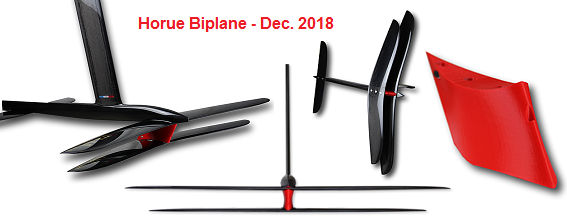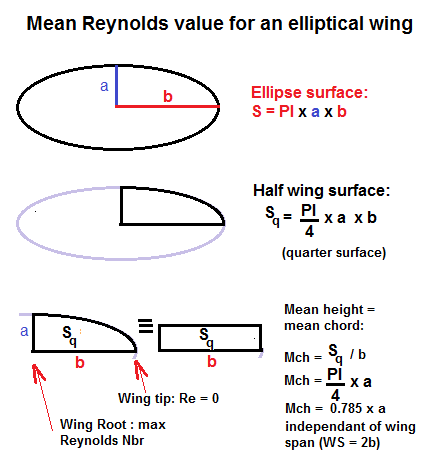Don’t want to ride with a huge front wing ? Why don’t you use 2 (or 3) small ones !
Horue (France) have just revived the… WW1 biplane.
https://www.windfoilzone.com/single-post/Horue-Biplane-foil-concept

[Box Wing] to be followed.
Don’t want to ride with a huge front wing ? Why don’t you use 2 (or 3) small ones !
Horue (France) have just revived the… WW1 biplane.
https://www.windfoilzone.com/single-post/Horue-Biplane-foil-concept

[Box Wing] to be followed.
I remember reading about how the lift/drag ratio of biplane type setups was a significant increase over single wings. If you have power to burn and really need a narrower wingspan, go for it. If you want efficiency, a winder single wing is the ticket.
It’s the low pressure in top of the lower wing interacting with the higher (relative) pressure zone on the upper wing that’s the issue. That staggered wing we see a little of here helps (as later biplanes also featured).
If I remember well, biplanes were abandoned due to huge drag. They are good for flying very slowly though
Has anyone considered having two wings but much greater spacing than shown above? What I suggest is wing “1” that will give lift only at low speed it would then be clear of the water when wing “2” is able to sustain the lift. This would eliminate the extra drag. ??? 
Ive seen the guys from https://www.facebook.com/www.elevate.rocks using this double wing setup in addtion to Canard setup. They said its good for early flying and stability. They ride with only 1kw… so this can`t be to bad.
@petertayler dont forget we are talking about water so dont forget high density… I don`t think there is this influence if these wings are more than 2 inch apart each other 
…it’s more to do with the reynolds numbers these two bi-plane wings work at are very different. Based on some quick numbers, a WW1 biplane would be in the ~500,000 range, and an efoil would be in the 10,000,000 range. That difference shows that’s it’s not really comparably. It’s much more complicated than just saying “don t forget we are talking about water so don t forget high density”.
Another big issue with biplanes was the change in direction of the flow from the top wing messing with the lower wing, and wingtip vortex creation from the smaller wing interacting with the larger one.
That’s a “ladder” setup. It’s been used in boats as a granular way to avoid an angle adjustment in the forward wing. https://goo.gl/images/7vJyfG
The idea being the faster you go, the more lift, and the fewer wings are in the water, creating less lift, and eventually getting to a balance point. Shallow water operation is obviously the problem though. V shaped “surface piercing wings” is another solution, but ventilation is the issue with that design, it’s also fairly draggy.
I read about a Human Power Hydrofoil design that had an additional take-off wing that could be retracted once flying. Sid Shutt maybe?
I don`t know how you got your reynolds numbers, but there seems to be your mistake… For efoil we are talking about reynolds number around 50.000-100.000 not 10milllions… see other discussions about wing profiles here 
I used an online calculator, depends on values chosen, could be i used a wing chord or speed that was wrong. Wanna post your (input) numbers? What characteristic length, and speed are you assuming? What values for density and dynamic viscosity?
Regardless, it’s hard to believe a biplane type setup is a very efficient design. Narrower? yes. Stiffer? maybe. Faster(/more efficient)? no.
Yes we had biplane wings on our efoil. Ideal to generate high lift at low speeds if you can not use large span by design. We did not notice any interference of the wings in the water channel with a wing distance of 5cm.
As far as your Reynolds numbers are concerned. Yes, an entire industry does not use optimal airfoils out there, since most of the hydrofoil profiles are from the 60s and designed for speeds above 50kmh. However, this is not the range where e-foils should fly …
That’s why many profiles out there work, but are not very efficient … Only the brand new wavefoils are going in the right direction, but still have development potential 
Interesting. !
I see a few other advantages such as car transportation leaving the foil mount unscrewed, decreased risk of falling and hurting oneself on the extreme sides of the foil since wings are shorter, less lateral stress on the mast, etc…
Did you ever feel any speed limitation due to your biplane wings, lack of stabilization going straight, or less stable turns ?
No, but at that time we where not interested in high speed setups…and if you place them a litle bit apart from each other on the longitudonal axis it feels a little bit more stable in pitch axis…as a 1 wing setup…
However 2 Wings always mean higher costs than one;-) But we think we will see a revival of this setup but more like a small wing at about 15cm below the board, which helps elevating in the low speed range and once board is stable flying it has no water contact any more and only the bigger lower wing is foiling…at least we did not cancel this idea so far…
I did the calculation with links and hypothesis here:
In water, for our chord lengths (10cm say), for our speed range (5 to 10 m/s ie 18 to 36 kmph), the Reynolds number ranges between 400K and 800 K (so neither sub 100K nor 10M ![]() ) given at wing root. And since we mostly have elliptical planforms, with (simple) mean chord [not the Mean Aerodynamic Chord or MAC] worth 78.5% (PI /4) of the root chord, you can consider that you have a mean Reynolds number of 0.785 time those values ie ranging from 310K (5m/s) to 620K (10m/s).
) given at wing root. And since we mostly have elliptical planforms, with (simple) mean chord [not the Mean Aerodynamic Chord or MAC] worth 78.5% (PI /4) of the root chord, you can consider that you have a mean Reynolds number of 0.785 time those values ie ranging from 310K (5m/s) to 620K (10m/s).
If you have a root chord of 15cm, instead of 10cm, you just multiply the 10cm values by 1.5
here 591K to 1.18M
Mean chord: yMch=(1/WS1)![]() Sydx (not quadratic), = chord of rectangular wing (therefore constant chord) with surface equal to reference elliptical wing
Sydx (not quadratic), = chord of rectangular wing (therefore constant chord) with surface equal to reference elliptical wing
Mean Aerodynamic Chord (MAC): yG=(1/S)![]() Sy²dx (quadratic) = chord of rectangular wing with same flight properties as reference elliptical wing (including center of lift). This line splits the wing in 2 equivalent surfaces (centre line of gravity)
Sy²dx (quadratic) = chord of rectangular wing with same flight properties as reference elliptical wing (including center of lift). This line splits the wing in 2 equivalent surfaces (centre line of gravity)
Any comment is welcome. Details of above calculations:
